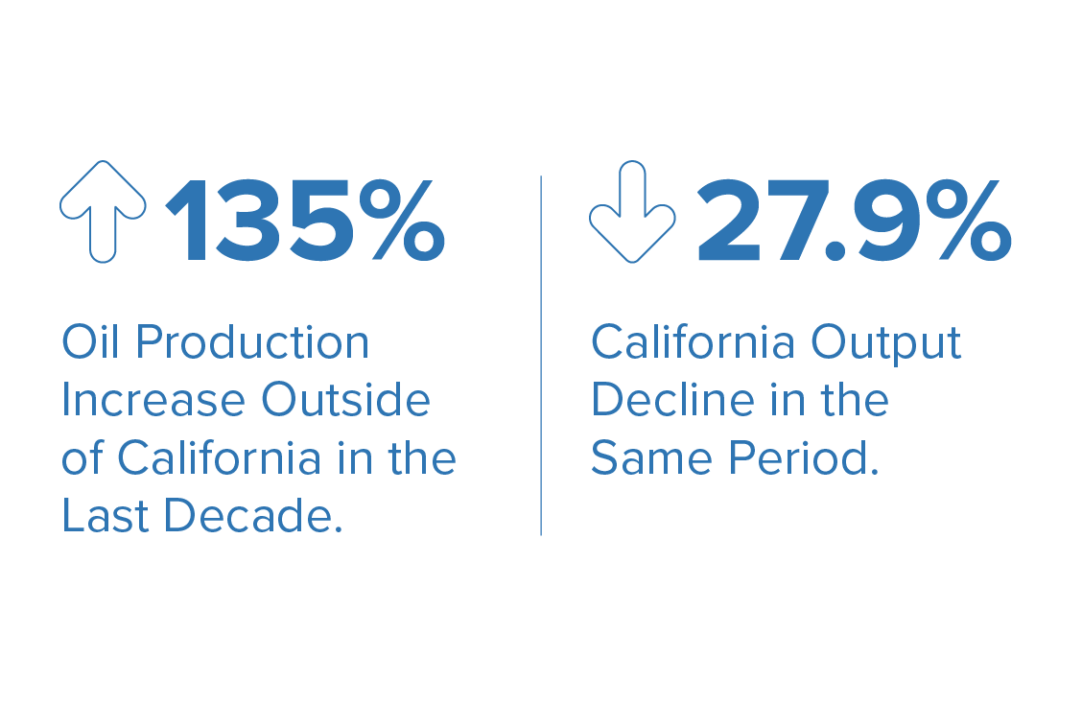
A look at oil and gas in California
California ranks 7th in U.S. oil production behind Texas, North Dakota, New Mexico, Oklahoma, Colorado and Alaska.
In 1985, California field production reached 394 million barrels. But since then, the figures have consistently dropped each year. In 2017, the state produced 173.2 million barrels — a 56 percent drop, according to the Energy Information Administration.

Californians rely on oil and natural gas
Californians consume more than 48 million gallons of gasoline each day, and the state’s 14 refineries supply consumers with gasoline and diesel in all or portions of California, Arizona, Nevada and Oregon.¹
California effectively is an “oil island,” with no pipelines linking the state to other crude oil production and refining regions. Despite its productivity, 70 percent of crude oil is imported to meet California’s energy needs, forcing the state to rely on domestic and international sources.² These external oil supplies, mostly from foreign countries, don’t apply California’s safety, labor, human rights, and environmental standards.
Natural gas is a clean, affordable, and efficient energy source that plays a crucial role in moving California closer to a low carbon future. Banning its use in municipal buildings, homes or business is not a mindful or inclusive way of planning for our state and nation’s energy future.

We are committed to safety and environmental integrity
Our member companies and their employees are fervently committed to continuous safety improvements and environmental standards in all its operations, whether that be through innovative technologies or by partnering with dozens of federal, state and local agencies that regulate oil & gas operation in California. Our priority as an industry is to maintain the safety and environmental integrity in the communities where we operate.
See an extensive list of legislative mandates and regulatory organizations.

The future of innovation is now
For years, WSPA member companies have been collaborating in the sustainable energy space with large investments in renewable energy like solar, wind and geothermal and research into advanced biofuels. Here are just a few examples of innovation in action:
Aera Energy will partner with GlassPoint Solar to build California’s largest solar energy project at the Belridge oilfield west of Bakersfield.
BP is one of the top wind energy producers in the US, enough generating capacity to power all the homes in a city the size of Philadelphia.
Approximately 30% of California Resources Corporation’s (CRC) purchased electricity comes from renewable sources.
Chevron’s photovoltaic projects at Questa, New Mexico, and in the San Joaquin Valley, California, test and evaluate solar technologies.
ExxonMobil continues to progress research on advanced biofuels to produce transportation fuels from algae and cellulosic biomass.
Phillips 66 has developed graphite anode materials for high-power lithium-ion batteries that are integral to the commercialization of advanced electric-powered vehicles.

We are working together to meet California’s climate goals
California can lead the way on climate policy by focusing on research and innovation and providing a model for cost-effective policies.
In fact, in 2016, California’s total statewide carbon emissions fell to 429 million metric tons, a drop of 12 million tons from the year before. The decline meant California met the Legislature’s goal of reducing emissions to 1990 levels, and did so a full four years before the target year of 2020!

The future of oil and gas in California
Oil and gas will remain a vital part of the state’s energy mix and economy for the foreseeable future. Therefore, we will continue to partner with our member companies, state, local and community leaders to provide safe, affordable, environmentally responsible fuels to millions of Californians.
We look forward to charting our sustainable energy future – together.
¹U.S. Energy Information Administration
²U.S. Census Bureau
